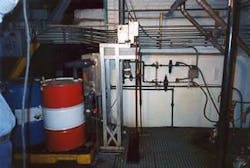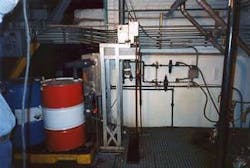Environmentally Friendly Cogeneration Plant Saves Time, Money with Oil Skimmer
The U.S. Environmental Protection Agency’s Performance Track Program honors accomplishments of manufacturing facilities that lead the way for improving their environmental performance (i.e., reducing air emissions and water consumption).
A member of this program, Brooklyn Navy Yard Cogeneration Partners L.P., has been recognized for its proactive efforts in this regard since April 2005. BNYCP and Palmark Inc., the onsite plant operation and maintenance (O&M) company, believes it’s their responsibility to do everything possible to ensure the plant is environmentally compliant.
The Brooklyn Navy Yard has a 286-megawatt plant that produces continuous duty of 220 megawatts of electricity and up to 1,000,000 pounds of steam per hour. The cogeneration facility’s environmentally friendly power plant has a waste stream that includes oily water waste that travels to a sump and is then processed by an oil/water separator. The processed mixture empties into the city sewer system and is treated in the nearby wastewater treatment plant.
Due to specific gravity and surface tension of the oily water waste, oil entering the sump separates to the liquid surface. This oil remains on the surface and isn’t pumped to the oil/water separators since a low sump level is maintained by a series of floats that turn the pumps on and off. Over time, dirt and particles can combine with the oil turning it into sediment/sludge heavier than water allowing it to fall to the bottom of the sump where it’s pumped through the oil/water separators.
Oil/Water Separators
The oil/water separators are designed to remove clean floating hydrocarbons; however since the sludge-laden hydrocarbons are heavier than water, they become trapped inside the piping, oil/water separator and auxiliary controls - interrupting the facility’s monitoring equipment and causing increased O&M costs.
Brooklyn Navy Yard invested in in-plant personnel time and outside contractors to clean the separator and the sump to keep them performing under the New York Department of Environmental Protection’s required hydrocarbon level of 50 ppm. These protocols weren’t only costly but time consuming.
“In an effort to reduce operation and maintenance costs, we began researching alternative maintenance solutions,” said Andrew Scano, former environmental safety and health coordinator for Palmark at the Brooklyn Navy Yard Cogeneration Facility. “I saw an ad for an Oil Skimmers Inc. and made a call to the sales representative. He had just recently installed an oil skimmer at a nearby Con Edison facility.”
Scano was responsible for regulatory reporting to federal, state and local environmental agencies, and managing operational permits. Scano, who now serves as the plant’s operations manager, arranged for a meeting with an Oil Skimmers sales representative to see the Model 6V oil skimmer in operation at the Con Edison facility.
Floating hydrocarbons
This oil skimmer efficiently removes floating hydrocarbons on the surface of water via a specially formulated collector tube that skims oil from the water surface. The oil adheres to the outside of the closed-loop tube, which is slowly drawn across the surface of the water and into the skimmer. The tube is drawn into the skimmer and through scrapers that remove the oil. The clean tube then returns to the water to skim more oil.
Skimming up to 100 gph, the Model 6V transports recovered oil to a collection container. The tube automatically adjusts to varying water levels and is flexible enough to be able to wind over and around floating debris. The skimmer is designed to recover oil 24 hours a day, seven days a week, unattended by an operator.
Within a month of seeing the ad, plant personnel installed the skimmer and saw immediate reduction in hydrocarbon concentration in the wastewater stream leaving the plant. It went from a continuous 15-25 ppm samples to zero.
“The hydrocarbons are now virtually undetectable,” said Scano. “We also saw the scum layer disappear and the water became clearer.”
He took samples of the wastewater stream and sent them to a New York certified lab, which confirmed only a very low level of hydrocarbon presence. Findings from the facility’s online continuous hydrocarbon analyzer and the lab results confirmed that the oil skimmer is the reason for the wastewater quality’s improvement.
Cost Reductions
The skimmer has been in place for about two years, and Brooklyn Navy Yard has seen a substantial decrease in maintenance costs. The plant has saved about $30,000 to $40,000 annually between in-house and contractor labor, and replacement parts for monitoring equipment.
“We used to spend about $4,000 to $6,000 every four months to have the sump pumped and skimmed, and another few thousand dollars to have the separator cleaned by contractors,” said Scano. “We also used to have a maintenance technician spend several hours per week cleaning and monitoring the equipment to maintain accuracy.”
Now, Brooklyn Navy Yard has reduced the annual operation and maintenance cost to about $10,000, which consists of routine cleaning of the skimmer, monitoring equipment and oil/water separators.
Conclusion
According to Scano, the positive feedback from the plant’s owner, Delta Power, has been overwhelming. It’s pleased with the efforts made by plant personnel and believes installing the oil skimmer further validates the plant’s EPA Performance Track Program membership. The New York DEP also is equally pleased with the reduction of hydrocarbons in the wastewater stream and the plant’s proactive efforts in making a difference.
“I think people in the industry need to be aware of different alternatives for reducing hydrocarbons,” said Scano. “We took an idea from the wastewater industry and applied it to the power industry. This technology goes across industry boundaries. It’s about being open to new technologies and learning how to apply them.”
Oil Skimmers Inc., of Cleveland, OH, has thousands of systems in operation - some for over 35 years - providing customized solutions for diverse manufacturing and industrial applications that require continuous removal of oil from process liquids and wastewater. Contact: 800-200-4603 or [email protected]


